Utilizing Office 365 Staged Migration to Mitigating Risk

Currently there are three scenarios for an Office 365 Migration. They are as follows:
- Cutover
- Staged
- Hybrid
The Cutover scenario requires the export of all email and content of an on-premise Exchange implementation. Once completed, all the exported data is then imported to Office 365, followed by changing the MX records. Risk to this scenario is dependent upon the Window of DNS cutover time as you may have mail flowing to the old environment or your STOP mail flow period.
The Hybrid scenario allows for a running an Exchange 2010 or Exchange 2013 implementation and a mailbox/trust is established with Office 365. This allows for the ability to migrate data from either on premise or in cloud seamlessly without affecting mail flow. This setup, provides minimal risk but is heavily dependant on connectivity.
In a staged migration scenario, Office 365 connects via Outlook Web Access from the on premise Exchange 2003 and/or Exchange 2007 environment and does an initial mirror of the entire mailbox. It then establishes SMTP forwarding of inbound emails to the destination Office 365 mailbox to ensure emails sent to the old address forward to the new. This takes a bit of technical know how to setup but provides a very low risk alternative to the cutover scenario if the Hybrid configuration is not an option.
A couple references found online have stated “After Migration is completed, disable the Exchange mailbox, flip the user to Mail-enabled, then reconfigure them to Office 365”
While this does work well for smaller migrations, it does not address migrations taking a 2-3 days or longer to complete. Too add, users that are in Office 365 can not communicate with users that are on premise other than receiving messages only. Also what about your rollback strategy?
The preference to not break or change anything drastically in the old environment until confirmation that the migration was successful is always recommended. More importantly if any issue that wasn’t plan for arises, it would be a comfort to IT administrators knowing that all data from Exchange will be there to rollback too should a situation occur.
Normally the configuration of Outlook for Office 365 is simple.
- Start Outlook
- Outlook checks to see if this email is part of Exchange
- Failing that it checks DNS to see if there is an Auto-discover record for it
- It gets the info from Auto-discover
- The user is prompted for an ID and password for Office 365
This provides enables interesting option of allowing users either the current domain email utilized and/or and Office 365 / onmicrosoft.com. To enable this, the attachment of the assigned email needs to be applied to corresponding Active Directory profile. This also enables a means for a rollback should the migration go wrong without actually deleting anything.
Also note that during your Staged Migration although MAIL will flow to the other side, changes to the local Calendar,Contacts,Notes and Tasks will not. The export/import of said data would be required to complete the rollback.